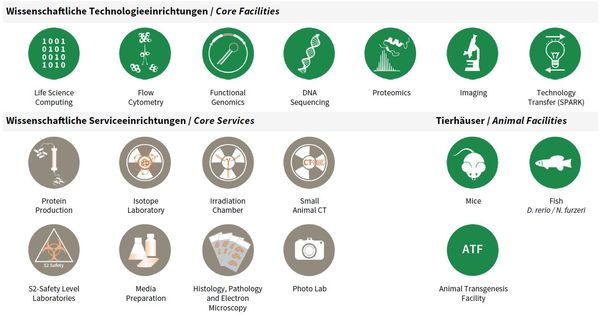Core Facilites and Core Services
At the beginning of 2016, a “core” structure was put into effect that organized facility and service units as independent organizational entities from FLI’s research groups. A number of technology platforms (e.g. sequencing, mass spectrometry) grew out of individual methodological requirements for single research groups in the last years but developed into semiautonomous substructures. As consequence of re-focused research activities and the concomitant advent of new research groups at FLI, those units increasingly had to serve many FLI groups and collaborative research efforts in the Jena research area.
To accommodate this development and to increase efficiency as well as transparency for users, facility personnel and for administrative processes, it came natural to re-organize such activities into independent units as “FLI Core Facilities and Services” and to phase out infrastructures considered non-essential for FLI’s research focus (X-ray crystallography and NMR spectroscopy).
FLI’s Core Facilities (CF) are managed by a CF Manager and are each scientifically guided in their activities and development by an FLI Group Leader, as Scientific Supervisor. The animal facilities comprising fish, mouse and transgenesis are run separately, as they involve a more complex organizational structure. Basic Core Services (CS) are directly led by the Head of Core (HC), who in turn is supported by individual CS Managers.
All facilities and services, including animal facilities, have a valuable contribution to FLI’s research articles; e.g. from 2016–2018, to 54% of all peer reviewed research publications.
Overview Core Facilities and Core Services at FLI.
Publications
(since 2016)
2025
- Metabolic modelling reveals the aging-associated decline of host-microbiome metabolic interactions in mice.
Best L, Dost T, Esser D, Flor S, Gamarra AM, Haase M, Kadibalban AS, Marinos G, Walker A, Zimmermann J, Simon R, Schmidt S, Taubenheim J, Künzel S, Häsler R, Franzenburg S, Groth M, Waschina S, Rosenstiel P, Sommer F, Witte OW, Schmitt-Kopplin P, Baines JF, Frahm C, Kaleta C
Nat Microbiol 2025, 10(4), 973-91 - The microcephaly-associated protein YIPF5 differentially regulates ER-export
Bruno F, Anitei M, Di Fraia D, Durso W, Dau T, Cirri E, Sannai M, Valkova C, Maldutyte J, A.Miller E, Rubio I, Garloff V, Kersten N, Farias G, Ori A, Mestres I, Calegari F, Kaether C
bioRxiv 2025, https://doi.org/10.1101/2025.06. - Oncogenic FLT3 internal tandem duplications (ITD) and CD45/PTPRC control osteoclast functions and bone microarchitecture.
Lossius-Cott C, Annoh A, Bens M, Nietzsche S, Hoffmann B, Figge MT, Rauner M, Hofbauer LC, Müller JP
JBMR Plus 2025, 9(3), ziae173 - DNA damage response regulator ATR licenses PINK1-mediated mitophagy.
Marx* C, Qing* X, Gong* Y, Kirkpatrick J, Siniuk K, Beznoussenko GV, Kidiyoor GR, Kirtay M, Buder K, Koch P, Westermann M, Bruhn C, Brown EJ, Xu X, Foiani M, Wang ZQ
Nucleic Acids Res 2025, 53(5), gkaf178 * equal contribution - Analysis of different strains of the turquoise killifish identify transcriptomic signatures associated with heritable lifespan differences.
Mazzetto M, Reichwald K, Koch P, Groth M, Cellerino A
J Gerontol A Biol Sci Med Sci 2025 (epub ahead of print) - The master male sex determinant Gdf6Y of the turquoise killifish arose through allelic neofunctionalization.
Richter A, Mörl H, Thielemann M, Kleemann M, Geißen R, Schwarz R, Albertz C, Koch P, Petzold A, Kroll T, Groth M, Hartmann N, Herpin A, Englert C
Nat Commun 2025, 16(1), 540 - Gene regulation by convergent promoters.
Wiechens E, Vigliotti* F, Siniuk* K, Schwarz R, Schwab K, Riege K, van Bömmel A, Görlich I, Bens M, Sahm A, Groth M, Sammons MA, Loewer A, Hoffmann S, Fischer M
Nat Genet 2025, 57(1), 206-17 * equal contribution
2024
- INHBA is enriched in HPV-negative oropharyngeal squamous cell carcinoma and promotes cancer progression.
Abou Kors T, Hofmann L, Betzler A, Payer K, Bens M, Truong J, von Witzleben A, Thomas J, Kraus JM, Kalaajieh R, Huber D, Ezić J, Benckendorff J, Greve J, Schuler PJ, Ottensmeier CH, Kestler HA, Hoffmann TK, Theodoraki MN, Brunner C, Laban S
Cancer Res Commun 2024, 4(2), 571-87 - Multi-omics analysis of overexpressed tumor-associated proteins: gene expression, immunopeptide presentation, and antibody response in oropharyngeal squamous cell carcinoma, with a focus on cancer-testis antigens.
Abou Kors T, Meier M, Mühlenbruch L, Betzler AC, Oliveri F, Bens M, Thomas J, Kraus JM, Doescher J, von Witzleben A, Hofmann L, Ezic J, Huber D, Benckendorff J, Barth TFE, Greve J, Schuler PJ, Brunner C, Blackburn JM, Hoffmann TK, Ottensmeier C, Kestler HA, Rammensee HG, Walz JS, Laban S
Front Immunol 2024, 15, 1408173 - Correction: IER3IP1-mutations cause microcephaly by selective inhibition of ER-Golgi transport.
Anitei M, Bruno F, Valkova C, Dau T, Cirri E, Mestres I, Calegari F, Kaether C
Cell Mol Life Sci 2024, 81(1), 465









